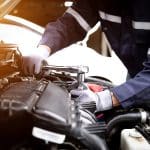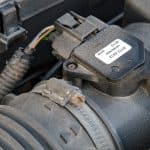
The throttle body is the part of the engine that mixes air with the fuel to allow combustion to take place. There are a number of symptoms that are often due to a failure in this part, including repeated stalling for no reason, problems with responsiveness of the acceleration pedal and stumbling or hesitation whilst accelerating.
Before completely replacing the throttle body it is always advisable to check that this part is clean and free from dirt. If you find that you are still having repeated acceleration issues with your car following the cleaning process, then a throttle body replacement is the next step. Due to the complex connections on the throttle body together with the procedure necessary to ensure that this part is safely in place, we would only recommend taking on this job if you have a good mechanical knowledge.
You will need: screwdrivers, socket set, spanners, needle pointed pliers.
Remove the Hose from the Throttle Body
Making sure that your engine is turned off, open the bonnet and locate the air filter case. When you have found this part, carefully follow the large hose using your hand until you reach the clamp connecting it to the engine. This is the throttle body. Next remove the hose from its seating and pull it away from the throttle body.
Detach the Air Cleaner
Remove the air cleaner from the engine, taking care to remove the hoses and ducts that supply the part with clean air. Next carefully unplug the electrical supply alongside any other sensor cables that are attached to the part, for instance in newer cars there may well be a sensor that monitors the air intake temperature, which must also be removed.

Deactivate Air Control and Throttle Position
When you have removed the air cleaner, deactivate the air control, which should be located on either side of the throttle body. When this is free from the throttle you should be able to disconnect the throttle position sensor, making sure that the leads are kept well away from the site of the throttle.
Remove Throttle Cables
Using your hands, gently ease open the throttle body to its full extent. This should give you enough slack to remove the throttle cables one by one. There may also be some water cables attached to the throttle body. If this is the case remove the hose clamps using pliers before you remove the hoses.
Unbolt the Throttle Body
Locate the four bolts that attach the throttle body in its place against the intake manifold and unbolt them using a socket set. Then carefully lift the throttle body off the intake manifold taking care to keep the seal between the parts intact.

Install the New Throttle Body
Keeping the seal carefully in place, put the new replacement throttle body into its place and connect it to the intake manifold using the four bolts. When these are sufficiently flush against the fixing then connect the throttle cables. As a final step you’ll need to put the air cleaner back in place before connecting the hose.
After changing the part, perform the following check as a final test. Start the engine and take the car for a test drive. On your return, let the engine idle for about two minutes and listen for problems in the idle, ensuring that it is smooth. If it is not, then there may be additional problems throughout your engine.













.png)